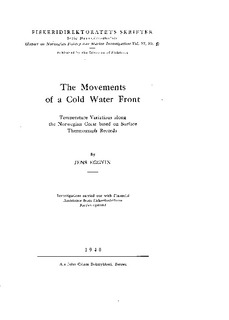| dc.description.abstract | The two, relatively new methods adapted in oceanographic research
-the permanent oceanographic stations in deep water and the registration
of sea temperature on board coasting steamers and liners, prove
effectively that they add to, and supplement the material collected on
the cruises of the research ships most valuable. Further, by the help
of these methods we have succeeded in solving important problems
which would otherwise have been insoluable by only using the material
obtained from the cruises.
An example has been described above as to how the distribution
of air pressure well in advance, can influence the herring fishery along
the west coast. From the results here arrived at we shall when next
a similar meteorological situation arises under comparable conditions of
temperature, be prepared to expect certain consequences. We shall know
reasonably far in advance when the (cold) Baltic water front will reach
the several parts of the south and west coasts. We shall then be able
to take our measures when it concerns the fishing. For a closer study
of the movements of the water front, we shall then be able to apply
the most suitable methods of investigation in ample time, and along
the best localities, and also to examine nearer what effect different sorts
of wind may have on the front after it has reached the Norwegian Coast.
By maintaining two permanent oceanographic stations in the
spring herring fishery district, one off Egersund and one off Bømlo,
we will together with the oceanographic observations taken by the
Flødevigen Hatchery near Arendal, the permanent station on the
Sognesjø, and the temperature registrations taken on the line steamers,
have at our disposal material that will allow of our being able
to follow the movements of the front fairly well, and also decide the
thickness of the penetrating watermass. A few oceanographic sections
from the coast and seawards will also be valuable. When then all this
auxiliary matter is established and tested, we shall be able to inform
the fishermen as to how the situation lies, how it seems to develop, and
what consequences it will have on the fishing. The fishermen will not
then have to waste their time in fishing on banks where the cold water
has already penetrated, but to seek deeper water, either along the slope
of the Norwegian Channel, or at suitable places in the fjords where
the depth is great enough, or that fishing be carried out in shallower
water (to the north) where the front has not yet passed.
Such a network of observations as here mentioned will be capable
of supplying valuable oceanographic information of other kinds also. | |
